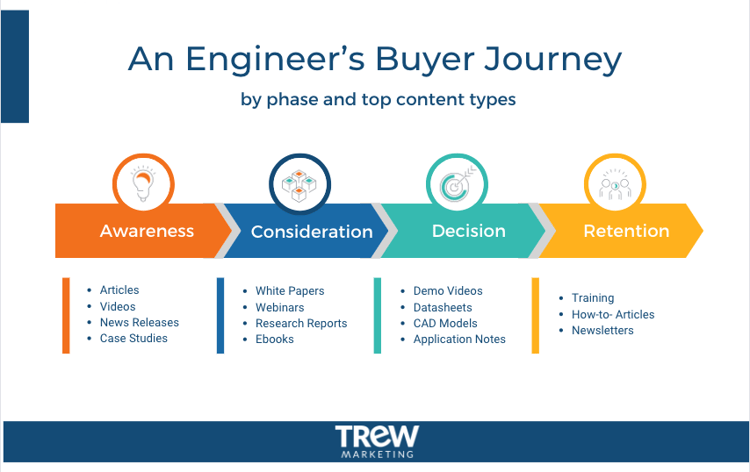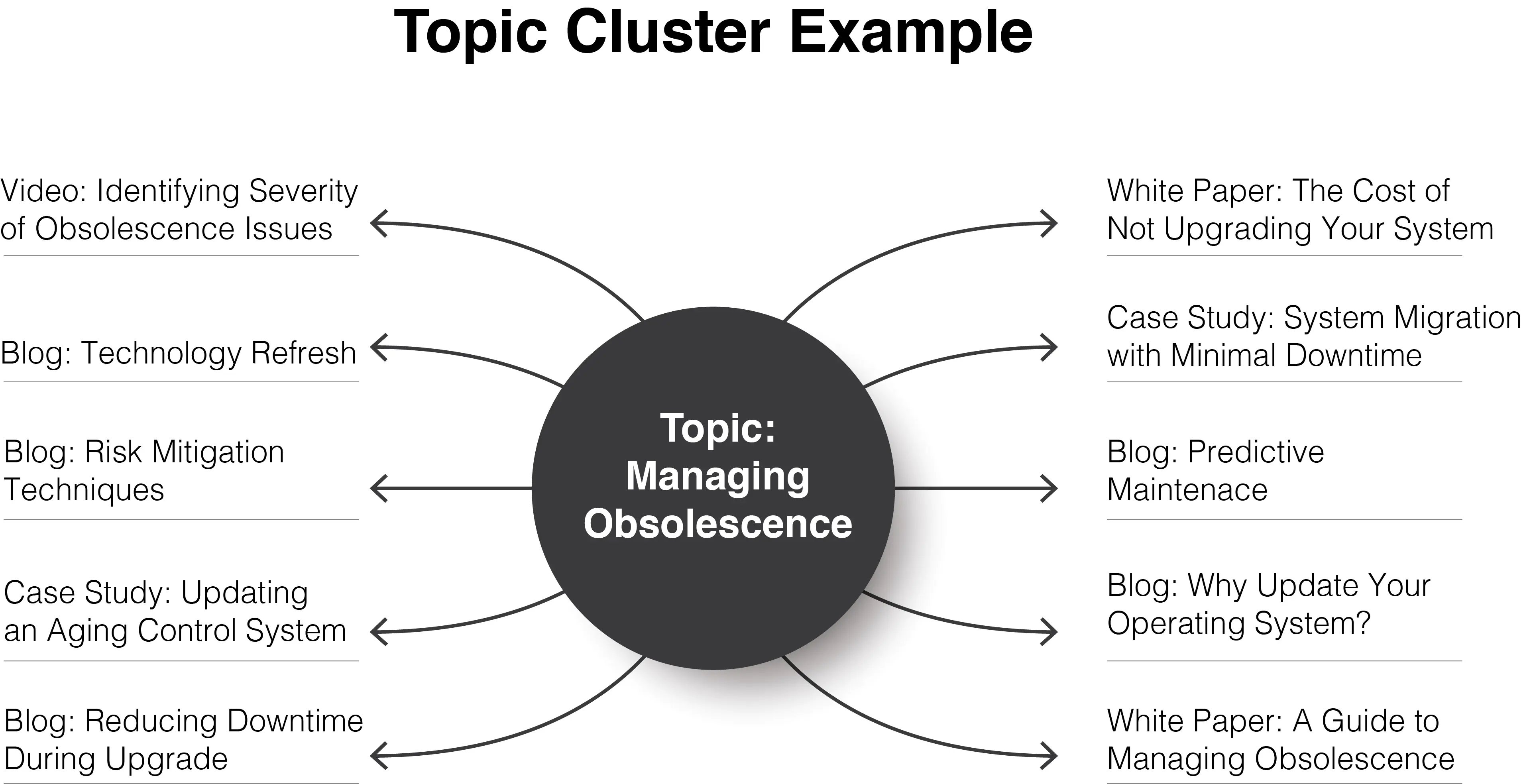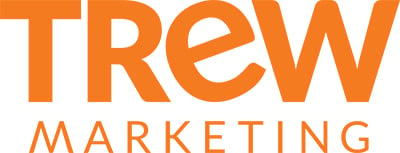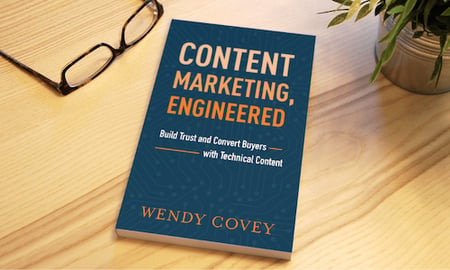AN ENGINEER'S GUIDE TO B2B CONTENT MARKETING
Fuel Your Marketing with Inbound Content

Introduction
Engineers want quality content
As a B2B technical company, you need a way to generate and convert leads in today’s digital age. Your marketing objectives include growing awareness, credibility, and brand trust; attracting new visitors and converting them into contacts; and generating more marketing-qualified leads. So how do you manage and prioritize all of your objectives to meet these goals?
Content is the fuel that powers your marketing plan and takes you toward your goals. The B2B buyer’s journey has transformed, especially for technical and engineering companies. In today’s world, consumers are constantly searching for information, testimonials, and examples of products and services that make their projects better, faster, and cheaper. Nearly all engineers prefer to do online research and evaluate vendors before talking to sales. The majority of engineers are more likely to do business with a company that regularly produces new and current content over one that does not. Content is THE deciding factor.
Gaining the trust of an engineering audience is not an easy task. They can tell the difference between material generated by marketing compared to that produced by your tech team. Producing smart, timely, and accurate technical content is essential if you want to successfully market to, and gain the trust of, a technical audience.
Content that attracts and resonates with the right audience must focus on what your target audience needs. Whether you’re creating a headline for your homepage, brainstorming a topic for your new white paper, or overhauling your corporate brand position and message, if you can’t quickly connect with your customers’ pains and show them how your company addresses them, they’ll move to a competitor who can.
Making the Case for Content Marketing
Content is a critical component to any inbound marketing program. It’s how new people find your company’s website, it educates prospects and compels them to continue to learn about and engage with you, and it ultimately builds trust between your business and your prospects and customers.
Content is Your Fuel
In our annual State of Marketing to Engineers research report, we found that 90% of respondents are more likely to do business with a company that regularly produces new or updated content.
We know technical audiences value doing business with companies that produce high-quality content. This begs the question as to whether or not you are committing enough time to content.
Is content at the center of your marketing program?
Do you put as much effort and as many resources into content marketing as you do trade show marketing, search engine optimization or online advertising?
In order for technical companies to get the most out of their marketing program and effectively fuel growth for the company, you must have content at the center of everything you do in marketing. That content will drive traffic, generate leads, and create qualified opportunities for sales.
How Content Wins Business
- Engineers Search for Solutions
A B2B technical buyer has a need and so they search for a solution using various words, phrases, and even questions until he sees relevant results appear. Does your content get found? - Content Gets Found Online
Your intriguing content is selected and you earn a website visit. Your content is the deciding factor in successfully getting visitors to come to your website. Now you must keep engaging your buyer. - Content Helps Close Business
Your buyer continues to engage with your brand through content on your website. Through email automation, you can lead your buyer further down the buyer’s journey until they are ready to talk with your sales team.
The ROI of Content Marketing
The buyer’s journey starts with a need, typically resulting in the individual searching online. They type in keywords and phrases to a search engine that correspond with their need until they find an answer. This individual is looking for smart, intriguing, and relevant content that will provide them with a solution.

In order to attract your target audience, you need to produce the content they are searching for. This can be done by regularly posting blogs that address current issues in their field, or conducting and publishing research, white papers or case studies. By anticipating your audience’s needs, you can produce material that will attract them to your website, engage and nurture them, and finally transform them into opportunities.
Unlike many other marketing activities, such as a trade show booth that is torn down at the end of the show or search advertising that ends the second you stop paying, content lives on indefinitely. You face an upfront cost to create content, but with regular optimization and promotion, that content can generate new interest for years to come.
In our research, we found that when engineers are in the buying process for a new product or service for work, their top preference is to search on vendor and distributor websites and read content first before talking to a salesperson (65%). Only 14% of engineers prefer to talk to a salesperson early in their research. The oldest engineers have the strongest preference (76%) to search on vendor websites before talking to a salesperson.
This raises the question: are you committing enough time to content marketing? A key reason why many companies do not commit to high-quality content development is because of the time it takes to do it well. Creating the highest quality technical content requires involvement from a select group of subject-matter experts within your company, and their time is incredibly valuable and in high demand. The burden is on the marketer to ensure that every minute of time these high-value resources spend on content is maximized.
To get the most out of your marketing program and effectively fuel growth, content must be at the heart of your marketing plan. It is through content that you will drive traffic, generate leads, and create qualified opportunities for sales.
Content marketing is a buyer-centric approach that anticipates the needs of a potential customer and caters content to those needs.
To get started with content marketing follow these five steps:
- Define Your Target Audience
- Develop Your Plan
- Create Content Topic Clusters
- Promote Your Content
- Measure Results
Define Your Target Audience
The first step in getting started with content marketing is defining your audience(s).
Categorize Your Primary Customer Types
When identifying and categorizing your customer types, you want to describe their goals, pain points, and purchasing process with as much detail as you can. To create a buyer persona, identify the following type of information:
- Who are they?
Demographics such as gender, age, and education - What is their job?
Include data such as title, company size, industry, and general job responsibilities - What is a day in their life like?
Describe what an average day is like for them, who they are dealing with, and what decisions they are making - What are their primary pain points?
Describe the primary challenges they are trying to overcome that relate to your products and services - What do they value most and what are their goals?
Explain what they value most in making a purchase decision (price, support, etc.), what they are trying to accomplish in each application - Where do they go for information?
Identify the primary sources they use to gather information in their research and purchase decision process - What’s important to them in selecting a vendor?
List what is most important, such as being a technology leader, having proven experience, being a domain expert, etc. - What are their most common objections?
List the reasons you hear most often for why your solutions won’t meet their needs Learn more about buyer personas, how to develop them, and review examples here.
Develop Your Content Plan
Now that you have identified your target audience, it’s time to start building out the rest of the components of your content plan. Great content doesn’t just happen; it requires establishing goals and objectives.
To help you get started on setting content goals and objectives, here are a few examples:
- Maintain steady cadence of content to attract, engage, and convert target audiences
- Grow thought leadership within our target market through relevant, in-depth content on trends, regulations, and reliable solutions
- Secure new contacts through content co-marketing initiative with key partners
Before you begin defining content for your target audience, consider how they will engage with your content in their evaluation of solutions to solve their unique problems.
Spend Time Creating Content that Converts
As you move down the funnel from attracting visitors to converting them into leads, your offers should become premium content that features more in-depth, technical information, gated by a form. As the perceived value of a piece of content rises, so does the amount of personal information a web visitor is willing to share to access it.
When deciding whether or not to gate content, one rule of thumb is to think about the level of technical effort the content took to create. Did this white paper require the involvement of subject-matter expert engineers? Is it more in-depth than your free content? Does it offer valuable how-to information or technical tips or trends that your audience desires and can’t easily find elsewhere?
Examples of converting content include:
- Technical white papers
- Thought leadership trend pieces
- Ebooks
- Tutorials
- Webcasts/webinars
- Research reports and surveys
- Resource kits with multiple pieces of content
- Online training or course material
- Interactive calculator
- Technical tools
- Technical project-related templates (e.g., reference designs)
Because producing content that converts requires a significant time investment, and because readers expect the content to be valuable, they will be open to the idea of completing a lead form. Putting a lead form in front of your premium, gated content, creates the opportunity to generate leads. Learn more about creating high-converting landing pages here.
Close Prospects with Content
You’ve attracted visitors with informative blog posts, then converted these visitors into leads with high-level white papers that have been gated with a landing page. How do you turn these new leads into customers?
The close phase should use automated email workflows to prove your experience and knowledge. Nurture contacts with relevant case studies, blog posts or white papers after they download a content offer from your site.
Examples of content that converts:
- Case study
- Customer testimonials
- Return on Investment (ROI) calculators and comparison charts
- Smart content targeted very specifically to the visitor
Putting a lead form in front of your premium gated content creates the opportunity to generate leads.
Continue to Engage Customers with Content
Your content plan doesn’t stop after you’ve closed a new client. Build a credible relationship with your client by sending them company news and relevant content right to their email inbox. You can easily set up email workflows with marketing service providers, such as HubSpot. Customers will dig deeper into your site to discover what else you offer that helps them do their jobs better, faster and/or cheaper, and this may lead to them adding on products/services or becoming promoters.
Examples of ongoing engagement content include:
- Enewsletter
- Employee bio blog post
- Company culture blog posts
- Surveys
How Much Content Do you Need & Who Should Write It?
When you are getting started with content planning, a common question and concern may be determining how much content you need and who can/should write it.
We recommend the following content types and frequency for year 1 of content marketing implementation:
- Monthly
- Two top-of-the-funnel content pieces
- Quarterly
- One piece of middle-of-the-funnel content
- One piece of bottom-of-the-funnel content
- Annually
- One-to-two topic clusters with pillar pages (see Step 3 in the next section of this guide)
- Two videos
- 1 infographic
With this approach, in one year you will have 24 pieces of top-of-the-funnel content, 4 pieces of middle-and-bottom-of- the funnel content, as well as dynamic visual content like videos and infographics. You will also need at least two topic clusters and two web pillar pages that will showcase all of the great content along the funnel that you are creating. We will discuss how frequently to promote this content in the next Step 4 of this guide
Defining who will create your content and how it will get created will ensure the content topics you’ve identified come to fruition with words on a page. You likely have many subject matter experts and levels of marketing expertise floating around your marketing organization. For that reason, creating content often becomes everyone’s problem (read: no one’s problem). There are a lot of hallway conversations and a lot of big ideas, but very few actual words on paper.
Here Are a Few Models for Content Creation:
- Internal: Your subject-matter experts and/or marketing resources write the content
- External: You outsource content development to an agency
- Hybrid: You hire an outside agency to write the content and pair them with your SME for content ideation
Stay Accountable with a Content Calendar
A content plan will strengthen your B2B marketing plan by showing exactly when and where you’ll publish content. You can pre-plan your content topics and create content in advance. With a content calendar, you’ll know exactly what will be written, who will be writing, when it needs to be published and the purpose of each piece up front. In addition, a content calendar will help you see how you can reuse and repurpose content throughout the year.
Your content calendar should be a spreadsheet that’s available for viewing by all stakeholders, including management, content writers, editors, and product marketers.
Your content calendar spreadsheet should include most of the following for each piece of content:
- Publish date
- Due data
- Content Type (blog post, Enewsletter article, web page, news release, case study, white paper, etc.)
- Topic
- Author
- Reviewer
- Related Campaign (as determined by your marketing plan)
- Audience Persona (this can help inform the tone or level of technical detail in the content)
- Funnel stage
- CTA (additional blog posts, gated content, contact for demo, etc.)
Create Content Topic Clusters
What are Topic Clusters?
As the trend towards mobile grows, search engines have adapted to new ways of user searches. For example: people no longer type “system integrator in Georgia” or “automation supplier in Atlanta” into a Google search bar. Instead, they pose full questions to search engines, such as “find a system integrator near me”, or “where can I buy automation equipment near me?”. Due to this new way of searching, search engines have evolved to understand the context of our searches.
Topic clusters are now king when it comes to search engine optimization. Building out topic clusters is a new SEO strategy that focuses on fully covering a topic and building relationships between keywords.
How to Build a Topic Cluster
Pick Your Topic
Start by figuring out a subject area that includes content topics that solve your target personas’ pain points, then build content around this topic to help prospects find you online. This should be a topic that is a cornerstone of your business and a service and that differentiates you from your competitors.
Conduct a content audit to see how much content and how many web pages you have in place already to best utilize your existing resources.
Brainstorm Your Subtopics
To build out a topic cluster, you need to brainstorm subtopics. Subtopics help to fully cover a topic in detail. Think about relevant content that your buyer personas would look for when researching a new solution or product. Subtopic content can include:
- Blog posts
- Case studies
- Infographics
- White papers
- Product pages
Be sure that all your subtopic content links back to your pillar page. For instance, if you pick the topic “industrial network security”, you would want to brainstorm relevant subtopics and content that an engineer would want to see when searching online for the term. Your brainstorming session might come up with a blog post/subtopic page with the title “How to Secure Your SCADA System from Cyber Attacks."
HubSpot is the primary automation software we use at TREW. The example we share use references this tool, which makes doing keyword research on your topic clusters very easy. When you go into HubSpot’s SEO tool, you can begin setting up your topic clusters. As you enter your topics and subtopics, HubSpot automatically pulls up keyword research on each term so you know the amount of searches per month your topics and subtopics receive.

Develop Your Pillar Pages
Your pillar page is the hub of all information related to your topic and subtopics and should aid your visitors along their buyer’s journey. If you already have service pages on your website, step one should be converting these service pages into pillar pages.
Be sure to thoroughly cover your topic, keeping your buyer personas needs front and center when building out your content.
Each pillar page should include the following content types:- Overview paragraph with value proposition and a compelling image
- Visual elements including icons to make the page scannable
- Content along the buying funnel, we recommend:
-
- One case study
- At least one piece of lead-generating
content like a white paper, ebook, or recorded webinar - An offer or next step to increase conversion for visitors who are ready to speak to a sales person
Use dynamic calls-to-action to inspire users to check out your subtopic content. A goal for every pillar page visit should be to increase awareness at the top of the funnel through blogs and case studies and grow new marketable contacts through lead-generating content.
To show Google that you are a trusted and reliable source on a topic or subject, you need to build topic clusters out on your site.
Link, Link, Link (Link Internally)
To show search engines how your topics and subtopics relate, you must link all your related pages. Your pillar page should include links to all subtopic content, such as relevant blog posts, case studies, white papers, etc. Additionally, your subtopic pages need to link back to the related pillar page.
This is the most important step when it comes to creating topic clusters. The internal linking between your topic and subtopic pages demonstrates to search engines that the content has a semantic relationship. In other words, Google understands your keywords are connected and related to one another.
To continue the example from above, if your
pillar page covers cybersecurity, then your
subtopic content might be a video demo on patch management, a blog post on emerging cyber threats and a white paper on building a secure control system network. You can link to as many pieces of subtopic content as you want. You also can include external links to other relevant content.
Linking completes your topic cluster and helps boost SEO for all pages in your topic cluster. It can also help you increase your domain authority.
Measure Results
Perhaps the most rewarding part of implementing topic clusters and pillar pages is seeing the results it will generate for your website over time. Using a marketing platform like HubSpot, you can track results of your content topic cluster content holistically and see which content is performing the best among your target audience.
Taking advantage of HubSpot’s analytics dashboard to track topic cluster performance, you have the ability to see which pages in a topic cluster perform the best and which pages might need to be improved or tweaked. When one page in your topic cluster performs well on search, all of the other pages in your topic cluster are rewarded and boosted thanks to the links you have built around your topic.
Promote your Content
Once you have identified your audience, developed content themes and thought out pillar pages, you next want to consider where and how frequently you will promote your content to drive awareness and traffic to your website. Just like you drew up a plan for the content creation, you should likewise create a plan for content promotion. The phrase “create it and they will come” does not apply here; you have to help people discover your content.
We find that many companies put content promotion on the back burner when thinking about their content marketing. If you want to see ROI from your content efforts, you must spend time promoting your content. Publishing your content on your website and forgetting about it won’t get you leads. But as you are just getting started with content development and promotion, start with a realistic focus and frequency.
Here are our recommendations for your first year:
- Where to promote your content:
- Feature in your quarterly Enewsletter
- Post to social media
- How frequently you should promote your content:
- Weekly
- Promote your content on social media. We recommended focusing on LinkedIn and Twitter as those are the top two social media channels for B2B technical audiences. Be sure to promote a mix of top-, middle-, and bottom-of-the-funnel content.
- Quarterly
- Promote one piece of content from each phase of the funnel in an Enewsletter to contacts in your database
- Weekly
Measure Results
How can you tell if your content is successful?
We like to say that year one of content marketing is a marathon, not a sprint! Much of your time will be focused on shoring up your marketing foundation to ensure you have identified your target audience, have messaging that attracts them and solves their pain points, and that you are writing and promoting high-quality content to reach them. Seeing results from content marketing takes time. And we can’t emphasize this enough. However, quality content done well, is like an annuity that will keep on paying dividends over time. So, the key metric to track in year-one is often more qualitative than quantitative: how many pieces of content did you create, and how frequently did you promote it.
If you followed our guidance on quantity of content to create weekly/monthly/annually, AND promoted it at our suggested frequency, you should expect to see the following high-level results:
- 10% increase in web traffic
- 20% increase in leads generated from the web
- >2 minutes time-on-site
- <60% bounce rate
If you want to start diving deeper and pulling additional content metrics, we have included a few of the most popular channels and metrics to track below:
Website Metrics
We suggest starting with Google Analytics to track the following metrics:
- Overall content page views
- Engagement metrics (bounce rate, time on site/page, and page views per session)
- Visit sources, to understand which promotion channels have been most influential
Submission Metrics
If your website is built in marketing platform like HubSpot, form submission metrics will be as accessible as the traffic metrics across the platform. Other content management systems (CMS) will have this information in a form plugin or even in a third platform. Wherever this information is stored, it will be crucial to monitor the following metrics for any gated content:
- Overall form submissions
- Visit-to-submission conversion rate (should be ~20% per page)
- New contacts from that piece of content
Promotion-Specific Metrics
The metrics you track will be dependent on the promotional tactics you use. Here are a few examples:
Social Media
- Overall engagement
- Click throughs on the content piece in social media
- Shares of the content piece
- Referral visits to the webpage from social channels
- New contacts and MQLs originating from social Blog Posts
- Visits
- Click-through rate from the promotional blog to the content piece
- Entrances/search traffic
Blog Posts
- Visits
- Click-through rate from the promotional blog to the content piece
- Entrances/search traffic
By consistently monitoring and reporting on content and content promotion, you’ll be able to continually optimize your content, making any adjustments as needed to improve performance and have good insights into content that performs well, going into year-two.
Conclusion
You now have the basics to get started with content marketing. You’ve learned why content marketing is such a critical part of your smart marketing strategy and where various content types fit along the buyer’s journey. You know about content along the funnel and the best ways to promote them. Lastly, you know what metrics you should be following to ensure that your content is performing at its best.
Content marketing doesn’t have to be a challenge. By using these tools, you can start using content to round out your overall inbound marketing plan and generate quality traffic and leads for your business.
Watch the Webinar
Getting Started with Content Marketing: Year One
Content is a critical component to any inbound marketing program. It’s how new people find your company’s website. Content educates prospects and compels them to continue to learn about and engage with you, and ultimately builds trust between your business and your prospects and customers.
Your marketing objectives include growing awareness, credibility, and brand trust; attracting new visitors and converting them into contacts; and generating more marketing-qualified leads.
During this webinar, Wendy Covey and Lee Chapman will share how B2B technical companies can generate and convert leads in today’s digital age.
During this webinar, Wendy and Lee will cover:
- How to Define Your Target Audience
- How to Develop Your Content Plan
- How to Create Topic Content Clusters
- Measuring Results
Speakers

Wendy Covey
CEO and Co-Founder
TREW Marketing
Wendy Covey is a CEO, technical marketing leader, author of Content Marketing, Engineered, one of The Wall Street Journal’s 10 Most Innovative Entrepreneurs in America. Over the last 25 years, Wendy and her team at TREW Marketing have helped hundreds of highly technical companies build trust and fill their pipelines through inbound marketing.

Lee Chapman
President
TREW Marketing
Prior to joining TREW, Lee was part of the corporate marketing leadership team at National Instruments (NI), where over the course of her 11-year career she served in various roles including Corporate Content and Community Relations Manager, Creative Strategy and Design Group Manager, and Brand Policy Manager. She now guides TREW's agency strategy and brings extensive B2B technical marketing experience across a spectrum of industries and application areas including test and measurement, control and automation, and industrial manufacturing.






